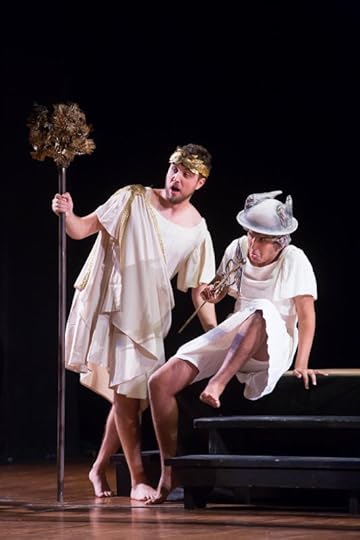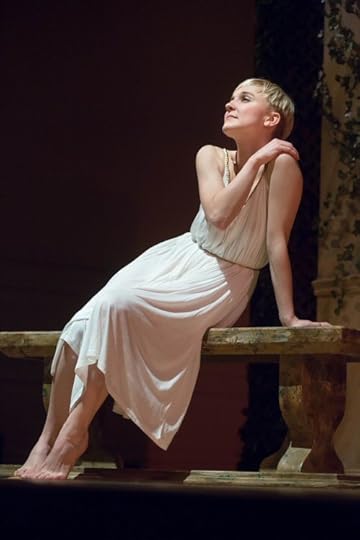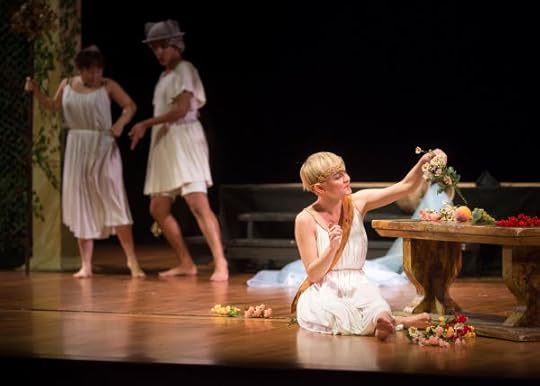 Roger’s
Comments
(group member since Aug 29, 2018)
Roger’s
Comments
(group member since Aug 29, 2018)
Roger’s
comments
from the Ovid's Metamorphoses and Further Metamorphoses group.
Showing 361-380 of 419
 Kalliope wrote: "Jove was impersonated as JFK."
Kalliope wrote: "Jove was impersonated as JFK."Ah yes, an intriguing reminder that many men whom we otherwise admire (Bill Clinton is another) can behave entirely unadmirably around women! R.
 Steve wrote: "Also, other than being burned to a crisp by Jove's awesome strike, in what manner was Phaethon 'metamorphosed'?"
Steve wrote: "Also, other than being burned to a crisp by Jove's awesome strike, in what manner was Phaethon 'metamorphosed'?"I suspect this is a question for Roman Clodia or some other literary historian. Just because the book is titled "Metamorphoses," does it necessarily mean that every story in it must involve a transformation? I don't know. R.
 Steve wrote: "…the complaint of the 'earth goddess' who, in most uncharacteristic fashion for Ovid, goes unnamed? Any idea why?"
Steve wrote: "…the complaint of the 'earth goddess' who, in most uncharacteristic fashion for Ovid, goes unnamed? Any idea why?"Thanks, Steve. I also noticed this throughout this book. I mentioned above that we get the name of Calisto from somewhere else, not from Ovid. Europa is just "Agenor's daughter." And there are many other characters who do not seem to be named at all. R.
 Kalliope wrote: "The beginning of Book II describing the 'artwork' of the doors of of the palace of the Sun, as made by Vulcan, is a beautiful ecphrastic section."
Kalliope wrote: "The beginning of Book II describing the 'artwork' of the doors of of the palace of the Sun, as made by Vulcan, is a beautiful ecphrastic section."Yes, that struck me too. And I immediately started wondering whether and where we could find the "reverse-ecphrastic version" (I love this concept!) of those doors as an actual artwork. But I didn't look, because I realized that even if some artist had attempted it, it would pale beside the original, caught between the competing demands of detail and scale.
So this is an example of ecphrasis that is not a mere substitute for some other medium, but a superior art form, because it describes an imaginary artwork whose physical representation could never match its presence in the mind. R.
 Kalliope wrote: "To depict Phaeton's fall is a great challenge and Rubens, unsurprisingly, felt he could meet it."
Kalliope wrote: "To depict Phaeton's fall is a great challenge and Rubens, unsurprisingly, felt he could meet it."If this is in Washington, I should know it, but I don't. It is truly magnificent, but I wonder if it is on permanent display?
[It is possible, though, that I have simply missed it. We visit the Washington NG about twice a year, but almost always for special exhibits, taking in only those sections of the permanent collection that catch our fancy that day. It occurs to me now that I don't know where the Rubens room is; next visit, I will make a point of looking out for it. R.]
 Ted Hughes has a very full treatment of the Phaethon story in his Tales from Ovid, Although I haven't counted words, I suspect it is quite a bit longer than the original. He starts, for example, with a page or more giving the back-story that explains Phaethon's doubts about his parentage, which of course set the whole thing in motion.
Ted Hughes has a very full treatment of the Phaethon story in his Tales from Ovid, Although I haven't counted words, I suspect it is quite a bit longer than the original. He starts, for example, with a page or more giving the back-story that explains Phaethon's doubts about his parentage, which of course set the whole thing in motion. Another thing that Hughes does—quite unusual for him—is to tell most of the first part of the story in more or less regular five-line stanzas (38 of them, to be precise). He seems to be setting up a sense of order—only to destabilize this order into irregular line-lengths and lurching phrases when Phaeton gives his borrowed steeds their rein:
They burst upwards, they hurled themselves
Ahead of themselves,
Winged hooves churning cloud.
They outstripped those dawn winds from the East—
But from the first moment
They felt something wrong with the chariot.
The load was too light.
More like a light pinnace
Without ballast or cargo,
Without the deep-keeled weight to hold a course,
Bucking and flipping
At every wave,
Sliding away sidelong at every gust.
The chariot
Bounced and was whisked about as if it were empty.
 I am finding this a rather confusing book. But more on that when I have had more time to puzzle it out.
I am finding this a rather confusing book. But more on that when I have had more time to puzzle it out.One story, though, jumps out at me immediately: that of Calisto (I use the Italian spelling; Ovid does not name her). Francesco Cavalli wrote a delicious opera on the subject in 1651, to a superb libretto by Giovanni Faustini. I was involved in the first modern revival of the opera at Glyndebourne in 1975; there is a rather poor video of that production here; various clips from more modern productions and a complete audio recording can be found online.
I have since done three productions of my own. The photos below are from the most recent of these—also the one with the lowest budget; it had a very simple set. They show, in turn, Jove and Mercury when they first spy Calisto; Calisto herself; and Jove as Diana (now sung by a mezzo) preparing to make his first approach.



In preparation for this production, I also wrote a long poem, "Calisto Retold," trying to recapture the particular mixture of myth, pathos, and outright comedy in Faustini's libretto. The passage below describes the scene that follows from the third picture above. Italicized portions are more or less translations of the sung text (which is really quite close to Ovid); the others are my own storytelling. R.
======
Now Jupiter returns, but who would know him,======
in bodice, dress, and buskins, with a bow?
The image of Diana (though advised
by Mercury to cut down the machismo),
he woos Calisto with unmatched charisma:
Budding blossom of my bosom,
little virgin, just emerging,
how could you be absent from your goddess?
For without you, mad about you,
I've no treasure, find no pleasure
in the hunt without my little novice.
He's not the greatest poet, but Calisto
sees no falseness in his cloying strain:
O Diana, dearest diva, you
who guide the silver orb around the earth!
Wild beasts took me from your presence,
depriving me of your beloved worth.
(We do not need to quote their further blisses,
for Jove intends to put things right with kisses.)
Calisto readily agrees. (Not here, not now—
this is a family show.) In ladylike
decorum, Jove suggests that they adjourn:
some grove more shady… brook more murmury…
some love-nest where they will not be observed.
So off they go, in happy roundelay,
exchanging kisses all the livelong day.
Incidentally, the Calisto of Cavalli and Faustini is not at all resistant to Jove's approaches, and does not even know what has happened to her. When she sees Diana, her immediate response is to thank her for what has happened and ask for more. And when answering Juno's question, "Did anything else happen between your goddess and you?", all she can say is "A certain sweetness that… I don't know how to tell you." Hmm.
 Historygirl wrote: "Thanks to all who posted paintings...."
Historygirl wrote: "Thanks to all who posted paintings...."Thank you, Historygirl. Two of the three moderators (Kalliope and myself) are renegade art historians, and I for one find it the most enjoyable part of the process,
Thank you too for your observations on gold, iron, and stone. I fear we have rather passed over those sections in favor of the big stories. R.
 Kalliope wrote: "I have just received the book that Elena recommended, and which is in the Bookshelf of the group Ovid and the Metamorphoses of Modern Art from Botticelli to Picasso.
Kalliope wrote: "I have just received the book that Elena recommended, and which is in the Bookshelf of the group Ovid and the Metamorphoses of Modern Art from Botticelli to Picasso.I have ordered it too, mainly for later use in the course I am proposing to teach a year from now. Thanks, Elena! R.
 Kalliope wrote: "In post 122, I added a second version by Rubens, of the Mercury and Argus, in the Dresden Museum also."
Kalliope wrote: "In post 122, I added a second version by Rubens, of the Mercury and Argus, in the Dresden Museum also."Yes, you did! Very like the Velasquez, only with the elements slightly rearranged. And then Rubens' pupil, Jordaens, with the addition of the second cow, which makes the picture pretty but blurs the story.
Rubens has the popular reputation of baroque excess, yet it is notable in his narrative paintings how clearly he cuts to the crux of the story. R.
 Kalliope wrote: "Roger wrote: "The Rubens sketch is marvelous, but how little his apprentice had learned from him! R."
Kalliope wrote: "Roger wrote: "The Rubens sketch is marvelous, but how little his apprentice had learned from him! R."The Curators at the Prado must think like you, since this painting is generally not on display..."
Just looking at this pair again, what interests me now is the morphology of Python: half boar, half snake. Where does that come from, I wonder? Indeed, there is a whole field here that I think Ovid leaves untouched: the mythical bestiary from Satyrs and Cenaurs on. R.
 Kalliope wrote: "I am attending a Seminar on Dutch art lately..."
Kalliope wrote: "I am attending a Seminar on Dutch art lately..."It would seem that attending lectures and seminars is almost your full-time occupation, Kalliope—or else a wonderful case of serendipity, since almost every topic seems connectable to something you have recently studied!
I write this in envy and wonder, not criticism. R.
 Thanks, Jim, though it was Roman Clodia, not me, who mentioned the blandness of the Innes. I do treasure the quirkiness of Ted Hughes, though, too.
Thanks, Jim, though it was Roman Clodia, not me, who mentioned the blandness of the Innes. I do treasure the quirkiness of Ted Hughes, though, too.As to criteria, it is emerging that we are juggling two. First, whether the text engages us as a piece of English literature. Against this, we have the question of truth to the original. Were this group to consist entirely of scholars, the second criterion would obviously be paramount (together with the necessary preliminary questions about whether the "original" itself really is that). But I most of us are coming to it, I think, as regular readers—though a few have a scholarly background, and a few more some Latin.
A bit of both in my case, but not enough to counter the primacy—for me—of that first criterion. If a prose translation does not engage me as a story, or a verse one give me the same transport of joy or curiosity that I get from reading good poetry, then why bother?
Period translations are another matter, since they filter the text through another aesthetic, triangulating it, as it were. In effect, my entire career has been concerned with reinterpreting period artifacts, so this is close to my heart. I am primarily referring to my work as an opera director, staging works from the 17th, 18th, or 19th centuries, and trying to find a bridge between their period and audiences in our own. But I have also done a number of translations of opera verse texts, and take particular interest in working out how to retain some aspects of the original form, within a language that can still work for English-speakers today. R.
 A thought: does anyone know of a BAD translation (other than through the way it is printed)? It seems that we are praising the version(s) we have landed with, but they can't all be good, can they? R.
A thought: does anyone know of a BAD translation (other than through the way it is printed)? It seems that we are praising the version(s) we have landed with, but they can't all be good, can they? R.
 Thanks, Ce Ce. My son is about to embark on a multi-year project retracing the voyage of the Beagle, and is trying to find ways of crossing the Atlantic under sail. At least you have some comfort and security! R.
Thanks, Ce Ce. My son is about to embark on a multi-year project retracing the voyage of the Beagle, and is trying to find ways of crossing the Atlantic under sail. At least you have some comfort and security! R.
 Oh, Peter, I hope you didn't take that as criticism! My point was just that Classics teachers (Greek is even worse) seem to take delight in making an arcanum out of their profession. When I was at Cambridge, college grace was read in Latin, but in an accent that was deliberately British, and bearing no relationship to any of the ways we had been taught in school. I gather the Catholic Church used to do much the same thing. R.
Oh, Peter, I hope you didn't take that as criticism! My point was just that Classics teachers (Greek is even worse) seem to take delight in making an arcanum out of their profession. When I was at Cambridge, college grace was read in Latin, but in an accent that was deliberately British, and bearing no relationship to any of the ways we had been taught in school. I gather the Catholic Church used to do much the same thing. R.

